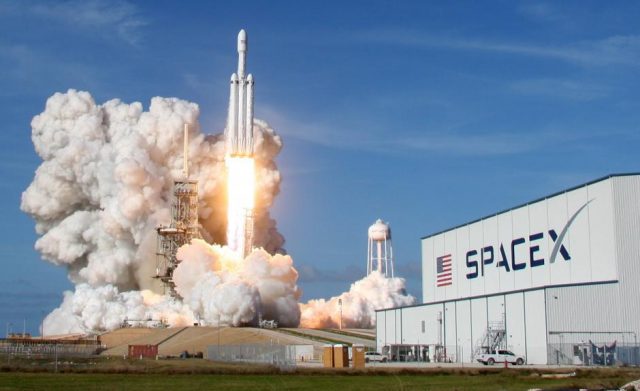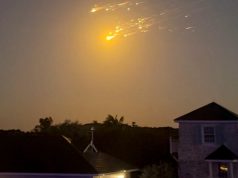
CAPE CANAVERAL, Fla. — The world’s most powerful rocket, SpaceX’s Falcon Heavy, roared into space through clear blue skies in its debut test flight on Tuesday from a Florida launch site where moon missions once began, in another milestone for billionaire entrepreneur Elon Musk’s private rocket company.
The 23-story-tall jumbo rocket, carrying a cherry red Tesla Roadster automobile into space as a mock payload, thundered off its launchpad in billowing clouds of steam and rocket exhaust at 3:45 p.m (2045 GMT) at the Kennedy Space Center in Cape Canaveral.
Boisterous cheering could be heard from SpaceX workers at the company’s headquarters in Hawthorne, California, where a livestream feed of the event originated. Several hundred spectators packed a campground near Cocoa Beach, 5 miles (8 kilometers) from the space center, to watch the blastoff.
Musk previously said one of the most critical points of the flight would come as two side boosters separated from the central rocket within three minutes of launch. That occurred seemingly without a hitch.
Then, capitalizing on cost-cutting reusable rocket technology pioneered by SpaceX, the two side boosters flew themselves back to Earth for safe simultaneous touchdowns on twin landing pads at Cape Canaveral Air Force Station about eight minutes after launch. The center booster was expected for a return landing on a drone ship floating at sea, but its fate was not immediately known.

Musk told reporters on the eve of the rocket’s test flight that he would “consider it a win if it just clears the (launch) pad.”
While the Falcon Heavy’s initial performance appeared, by all accounts, to have been near flawless, it remained to be seen whether the upper stage of the vehicle and its payload would survive a six-hour “cruise” phase to high Earth orbit through the planet’s radiation belts.
Turning point
The launch, so powerful that it shook the walls of the press trailer at the complex, was conducted from the same site used by NASA’s towering Saturn 5 rockets to carry Apollo missions to the moon more than 40 years ago. SpaceX has said it aspires to send missions to Mars in the coming years.
The successful liftoff was a key turning point for Musk’s privately owned Space Exploration Technologies, which stands to gain a new edge over the handful of rivals vying for lucrative contracts with NASA, satellite companies and the U.S. military.
Falcon Heavy is designed to place up to 70 tons into standard low-Earth orbit at a cost of $90 million per launch. That is twice the lift capacity of the biggest existing rocket in America’s space fleet — the Delta 4 Heavy of rival United Launch Alliance, a partnership of Lockheed Martin Corp. and Boeing Co. — for about a fourth the cost.
The demonstration flight put the Falcon Heavy into the annals of spaceflight as the world’s most powerful rocket in operation, with more lift capacity than any space vehicle to fly since NASA’s Saturn 5, which was retired in 1973, or the Soviet-era Energia, which flew its last mission in 1988.
Propelled by 27 rocket engines, the Falcon Heavy packs more than 5 million pounds of thrust at launch, roughly three times the force of the Falcon 9 booster rocket that until now has been the workhorse of the SpaceX fleet. The new heavy-lift rocket is essentially constructed from three Falcon 9s harnessed together side by side.
Going along for the ride in a bit of playful cross-promotional space theater was the sleek red, electric-powered sports car from the assembly line of Musk’s other transportation enterprise, Tesla Inc.
The Tesla Roadster is supposed to be sent into a virtually indefinite solar orbit, on a path taking it as far from Earth as Mars. Adding to the whimsy, SpaceX has planted a space-suited mannequin in the driver’s seat of the convertible.
Whether the car makes it onto its planned trajectory will not be known before late on Tuesday, SpaceX said. The roadster, which carries a plaque inscribed with the names of more than 6,000 SpaceX employees, could instead end up in Earth orbit.
The launch followed an impressive run of successful paid missions — 20 in all since January 2017, when SpaceX returned to flight following a 2016 launchpad accident that destroyed a $62 million rocket and a $200 million Israeli communications satellite that it was to put into orbit two days later.
SpaceX had previously announced plans to eventually use the Falcon Heavy to launch two paying space tourists on a trip around the moon and back. Musk said on Monday he was now inclined to reserve that mission for development of an even more powerful SpaceX launch system, the Big Falcon Rocket, or BFR, which he said was proceeding more quickly than expected.









